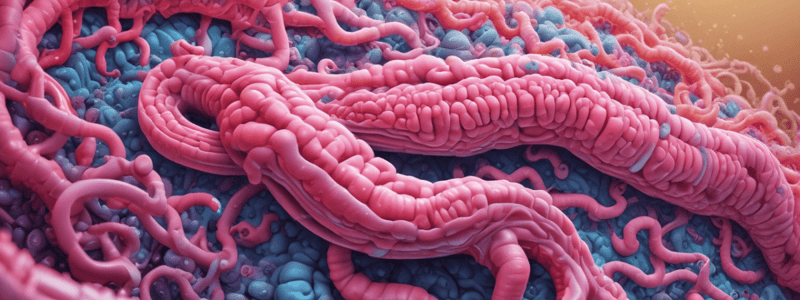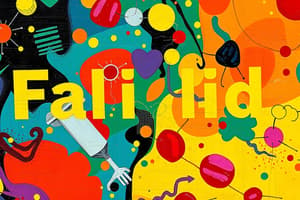Podcast
Questions and Answers
What is the primary purpose of emulsification in lipid digestion?
What is the primary purpose of emulsification in lipid digestion?
- To inhibit lipase function
- To increase surface area of lipid droplets (correct)
- To reduce enzyme activity
- To decrease surface area of lipid droplets
Which phase of lipid digestion involves the breakdown of TAGs into 1 MAG and 2 FFA?
Which phase of lipid digestion involves the breakdown of TAGs into 1 MAG and 2 FFA?
- Hydrolysis (correct)
- Absorption
- Emulsification
- Micelle formation
What is the function of bile salts in lipid digestion?
What is the function of bile salts in lipid digestion?
- Inhibit lipase activity
- None of the above
- Emulsify fat droplets (correct)
- Act as a storage medium for lipids
What is the role of peristalsis in lipid digestion?
What is the role of peristalsis in lipid digestion?
Which component is NOT part of bile?
Which component is NOT part of bile?
What are the end products of lipid digestion after hydrolysis in the presence of cholesteryl esterase?
What are the end products of lipid digestion after hydrolysis in the presence of cholesteryl esterase?
What is the consequence of reduced hydrolysis of fats by pancreatic lipase?
What is the consequence of reduced hydrolysis of fats by pancreatic lipase?
Which type of molecules form mixed micelles in lipid digestion?
Which type of molecules form mixed micelles in lipid digestion?
What is the primary site of lipid absorption?
What is the primary site of lipid absorption?
Where does re-esterification of lipids take place?
Where does re-esterification of lipids take place?
Where are the soluble micelles transported in the process of lipid digestion?
Where are the soluble micelles transported in the process of lipid digestion?
Which component is absorbed at the brush border membrane of the enterocytes?
Which component is absorbed at the brush border membrane of the enterocytes?
What are the end products of re-esterification transported to for maturation?
What are the end products of re-esterification transported to for maturation?
What peptide hormone is produced by I-cells in the duodenum?
What peptide hormone is produced by I-cells in the duodenum?
What is the main function of bile salts in the digestive process?
What is the main function of bile salts in the digestive process?
What is the function of chylomicrons?
What is the function of chylomicrons?
Which vitamins combine with FFA, free cholesterol,bile salts, and MAG to form mixed micelles?
Which vitamins combine with FFA, free cholesterol,bile salts, and MAG to form mixed micelles?
Where are SCFA and MCFA immediately released after absorption?
Where are SCFA and MCFA immediately released after absorption?
What do SCFA and MCFA bypass in the lipid digestion process?
What do SCFA and MCFA bypass in the lipid digestion process?
What structures are chylomicrons composed of?
What structures are chylomicrons composed of?
What triggers the production of secretin?
What triggers the production of secretin?
Which of the following is NOT stimulated by cholecystokinin (CCK)?
Which of the following is NOT stimulated by cholecystokinin (CCK)?
In which tissue does the degradation of triacylglycerols (TAG) into free fatty acids and glycerol primarily occur?
In which tissue does the degradation of triacylglycerols (TAG) into free fatty acids and glycerol primarily occur?
Which hormone stimulates the secretion of bile from the gall bladder?
Which hormone stimulates the secretion of bile from the gall bladder?
How does an insufficiency of pancreatic lipase affect the process of fat absorption?
How does an insufficiency of pancreatic lipase affect the process of fat absorption?
What is the most likely cause of steatorrhea in a patient who is losing weight, eating normally, and is now eating their feces?
What is the most likely cause of steatorrhea in a patient who is losing weight, eating normally, and is now eating their feces?
What is a correct example of re-esterification?
What is a correct example of re-esterification?
What triggers the production of cholecystokinin (CCK)?
What triggers the production of cholecystokinin (CCK)?
Where is cholecystokinin (CCK) produced?
Where is cholecystokinin (CCK) produced?
What is the fate of glycerol produced from the breakdown of TAG?
What is the fate of glycerol produced from the breakdown of TAG?
Where can FFA go after being produced?
Where can FFA go after being produced?
What is the main function of lipoprotein lipase (LPL) in the capillaries' endothelial cells?
What is the main function of lipoprotein lipase (LPL) in the capillaries' endothelial cells?
What is the main function of pancreatic lipase?
What is the main function of pancreatic lipase?
In severe cases of lipid malabsorption and maldigestion, patients can develop coagulopathy from the deficiency of which vitamin?
In severe cases of lipid malabsorption and maldigestion, patients can develop coagulopathy from the deficiency of which vitamin?
What will stimulate bicarbonate (HCO3) secretion from the pancreas to neutralize (raise) the pH to what is optimal for pancreatic enzymes?
What will stimulate bicarbonate (HCO3) secretion from the pancreas to neutralize (raise) the pH to what is optimal for pancreatic enzymes?
What peptide hormone is produced by S-cells in the duodenum?
What peptide hormone is produced by S-cells in the duodenum?
Flashcards are hidden until you start studying
Study Notes
Lipid Digestion and Absorption
- Lipids are packaged into chylomicrons in the Golgi apparatus, which are then released into the lymphatic vessel (lacteals) via exocytosis.
- Chylomicrons travel through the thoracic duct and left subclavian vein, entering the blood.
Control of Lipid Digestion
- Pancreatic secretion of lipase is controlled by hormones cholecystokinin (CCK) and secretin.
- CCK is produced by I-cells in the duodenum in response to lipids and proteins entering the small intestine.
- CCK stimulates:
- Bile secretion from the gallbladder
- Digestive enzyme secretion from the pancreas
- Decreased gastric motility
- Secretin is produced by S-cells in the duodenum in response to low pH of chyme in the stomach.
- Secretin stimulates:
- Bicarbonate (HCO3) secretion from the pancreas to neutralize pH
Lipid Assimilation
- Lipid assimilation occurs in four phases: emulsification, hydrolysis, micelle formation, and absorption.
- Emulsification increases the surface area of hydrophobic lipid droplets, making them accessible to lipase.
- Emulsification is completed by mechanical mixing due to peristalsis and detergent properties of conjugated bile salts.
Lipid Digestion: Emulsification
- Emulsification starts in the stomach and continues in the duodenum.
- Bile salts are amphipathic derivatives of cholesterol, synthesized by the liver and stored in the gallbladder.
- Bile salts emulsify fat droplets, allowing lipase to bind and hydrolyze lipids.
Lipid Digestion: Hydrolysis
- TAGs are hydrolyzed by pancreatic lipase and co-lipase into 1 MAG and 2 FFA.
- CE is hydrolyzed by cholesteryl esterase into cholesterol and FFA.
- Phospholipids are hydrolyzed by phospholipases into lysophospholipid and FFA.
Lipid Digestion: Mixed Micelles
- Hydrolytic products combine with bile salts to form mixed micelles.
- Mixed micelles transport lipids from the gut lumen to the mucosal layer.
- Lipids are transported into close contact with the absorptive surface of the enterocytes.
Lipid Digestion: Absorption
- Products of lipid hydrolysis, including FFA, free cholesterol, and MAG, combine with bile salts and lipid-soluble vitamins to form mixed micelles.
- Mixed micelles are transported to the brush border membrane of the enterocytes.
- The majority of fats are absorbed in the enterocytes, with little fat found in fecal matter.
Lipid Digestion: Re-esterification
- Lipids are re-esterified in the smooth ER (sER) of the enterocytes.
- MAG is converted to TAG, lysophospholipid is converted to phospholipid, and cholesterol + FFA are converted to CE.
- Re-esterification is essential for the formation of chylomicrons.
Lipid Digestion: Re-esterification and Secretion
- The end products of re-esterification are transported to the Golgi apparatus for chylomicron maturation.
- Chylomicrons are lipoproteins with a spherical structure, composed of a TAG and CE core, surrounded by phospholipids and cholesterol.
- SCFA and MCFA are not re-esterified, instead, they are released into the hepatic portal system and transported to the liver.
Case Study: Pancreatic Exocrine Insufficiency
- A patient with pancreatic exocrine insufficiency presents with steatorrhea (fat in the feces), due to a lack of pancreatic lipase.
- Without lipase, fats cannot be hydrolyzed to fatty acids for absorption, leading to steatorrhea.
Studying That Suits You
Use AI to generate personalized quizzes and flashcards to suit your learning preferences.





